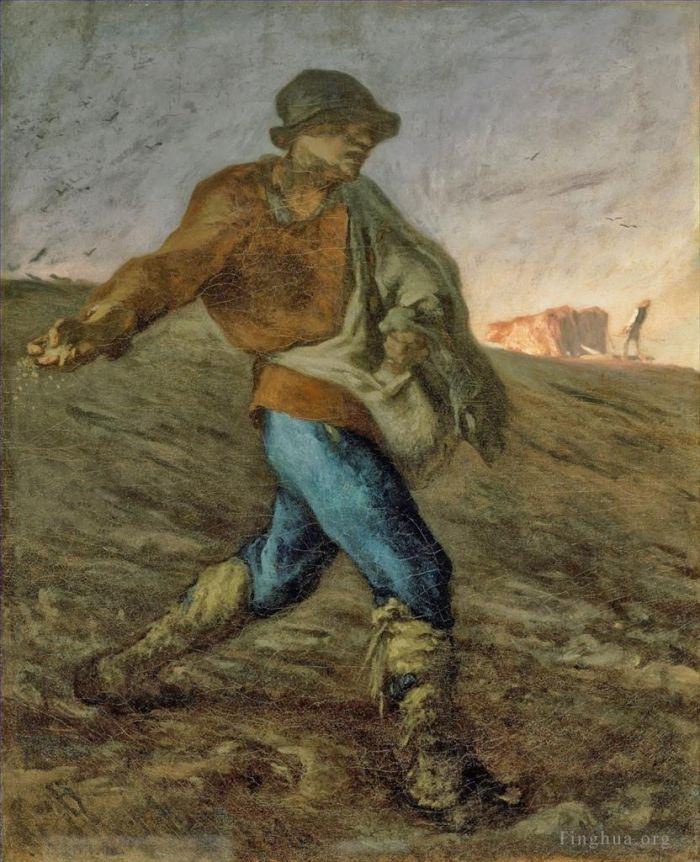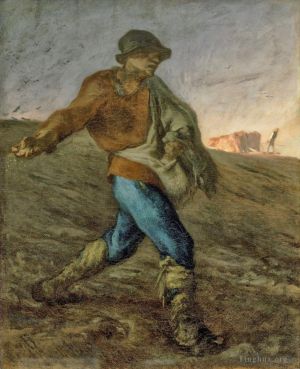The Sower
Jean-Francois Millet
- Price: Price on Request
- Art Type: Oil Painting
- Size:
- English Comments: 0
- International Comments: 0
- Creating Date:
- Introduction and Works of Jean-Francois Millet >>
Keywords:
Sower
Work Overview
- The Sower
Jean-Francois Millet
Original Title: Le semeur
Date: 1850
Style: Realism
Theme: Sower (1850-1870)
Genre: genre painting
Media: oil, canvas
Dimensions: 101.6 x 82.6 cm
Location: Museum of Fine Arts (MFA), Boston, MA, US
Jean-François Millet was the artist that van Gogh most revered. Although he never saw Millet’s famous Sower - already in a Boston collection before he was born - van Gogh admired Millet’s other treatments of the theme, and sought to emulate them. At the very beginning of his career, he wrote that “I must draw diggers, sowers, men & women at the plough, without cease… I no longer stand as helpless before nature as I used to do.”
In 1850 Millet entered into an arrangement with Sensier, who provided the artist with materials and money in return for drawings and paintings, while Millet simultaneously was free to continue selling work to other buyers as well.[10] At that year's Salon, he exhibited Haymakers and The Sower, his first major masterpiece and the earliest of the iconic trio of paintings that would include The Gleaners and The Angelus.
A man with a bag of seeds across his chest strides, long-legged across the extreme foreground of the canvas as he flings his right arm out to scatter handfuls of seed. As he works a flock (properly known as a 'murder') of crows circles behind him on the left, and highlighted in the distance on the right, a man behind a plow drives his team of oxen, preparing the soil for planting.
By the time Millet created this work, he had already fled Paris that was going through political upheavals and settled in nearby town of Barbizon. What sets Millet's work apart from his Barbizon school compatriots is that, while they emphasized landscape, particularly of the forests, he emphasized the human figure, often a rural laborer isolated in the fields. As he said "My dream is to characterize the type," and here, he creates the common man as laborer. The art historian Alexandra Murphy wrote, "among countless prototypes, the illustrations for October in the Très Riches Heures of the Duke de Berry, depicting a similar sower - capped, wearing leggings, and holding his seed bag in his left hand - is often suggested as a source for Millet. But as with so many of his images, The Sower is more likely to have evolved from the conflation of several well-studied visual memories."
At the Salon of 1850-1851, the painting was both praised and attacked. While the art critic Clement de Ris saw it as "an energetic study full of movement," the critic Théophile Gautier described it as "trowel scrapings." The American poet, Walt Whitman, praised its "sublime murkiness and original pent fury," and saw in it the prototype of Creative Man, sowing the seeds of a new age.
As muscular and heroic as Michelangelo's figures, and looming over the landscape like Goya's giants, the figure occupies much of the foreground, dominating the canvas. Art historian, Anthea Callen, noted, "Millet intentionally transformed his human laborer into a sinewy giant of a man by elongating his proportions...Reinforced by the sower's dominance of the pictorial space and our low viewpoint, his menacing appearance to the Parisian bourgeoisie in 1850 is thus readily explicable."
Despite Millet's liberal use of shadow his use of primary colors allows the figure to stand in stark relief against a field of earth tones. This is a practice used often and to great effect by great renaissance masters including Leonardo da Vinci and Raphael Sanzio. The painting's sense of vigorous movement is underscored by the wealth of dynamic angles that radiate outward from its central figure. The small figure rendered vaguely on the sunlit horizon, tilts back, its angular line further emphasizing the downward movement. The placement of the day's waning light behind the sower emphasizes the shadowiness of foreground. His eyes obscured by his hat, his clothes dirty from his labors, and the crows wheeling after him, eating up the seeds, undoing his efforts all create the sense that he is 'everyman' trying to outrun the gathering darkness.
- Copyright Statement:
All the reproduction of any forms about this work unauthorized by Singing Palette including images, texts and so on will be deemed to be violating the Copyright Laws.
To cite this webpage, please link back here.
- >> English Comments
- >> Chinese Comments
- >> French Comments
- >> German Comments
- >>Report
- The Walk to Work Le Depart pour le Travail
- Autumn Landscape with a Flock of Turkeys
- Norman Milkmaid
- Harvesters Resting Ruth and Boaz
- Faggot Carriers
- Portrait of a Man
- The Angelus
- Leconte de Lisle
- Pastures In Normandy
- Vert The Nuns Parrot
- Woman with a Rake
- Shepherdess with Her Flock
- Dandelions
- In the Garden
- Peasant Spreading Manure
- Landscape With Two Peasant Women
- Couseuse Endormie
- Louise Antoinette Feuardent GTY
- Garden TGT
- Portrait Of Eugene Canoville
- Man with a Hoe
- Spring
- Haystacks Autumn
- The Sower
- The Gleaners
- The Bather
- Young Woman
- Un Tailleur De Pierres
- Composition de F Millet
- Landscape Hillside in Gruchy Normandy
- Portrait Of A Man Said To Be Leopold Desbrosses
- The Drunkeness Of Noah
- The Flight into Egypt
- Fishermen
- Shepherdesses Seated In The Shade
- Femme Etandant Sonlinge
- A Shepherdess And Her Flock
- Garden Scene
- Le Nourrisson or Lenfant Malade
- Bucheron Preparant Des Fagots









 Singing Palette
Singing Palette